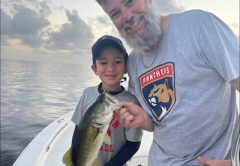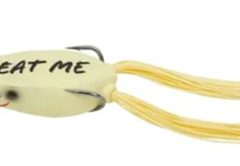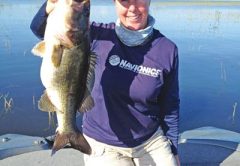Every fisherman dreams of the day they catch a trophy fish. Whether you’re fishing fresh or salt water there will come a day when you land that big fish and you’ll face the decision as to what you’re going to do with your trophy. Are you going to take it home for dinner, have it skin mounted, or perhaps have a fiberglass replica created and release the fish to fight another day. The reality is that you need to have decided this before you got on the boat for the three options have their own set of requirements. The one common thread among the three options is that you’ll probably want to get some nice pictures for your scrap book and to share with your friends. But stop right there, one style of picture will not satisfy all situations.
If you’re going to take pictures for your scrap book or bragging rights you’ll need to ‘compose’ the shot to highlight the fish, you, and the background scenery. In the excitement of the moment this is a lot harder than you might think. The first order of business should be protecting the fish, keep it in the water or live well until you’re ready to take pictures. After the fish is secured it’s time to calm down, take a few deep breaths and relax. The excitement of landing a hawg often leads to missed opportunities when taking a photo so relax and get yourself organized. Next tidy yourself up, you’re going to want to show the world your great catch so organize yourself so you look respectable and not some lost cousin from the backwoods. Once you’re ready, confirm your camera settings and if your fishing buddy is going to play cameraman make sure they know how to use the camera. Now that you are ready to compose the shot make sure the lighting is behind the camera and that the fish is not reflecting light as to create a glare in the photo. Make the photo interesting, fill the frame with the fish, you, and some quality background. Lastly, don’t depend on just one photo, with the advent of digital cameras and cellphone cameras, inspecting the photo can be done in real time, so look at the photo to ensure it’s an image worth sharing, for once the fish is released the opportunity is gone.
If you’re taking a picture of that 13.5-lb Hall of Fame bass to enter in FWC’s Trophy Catch program, the requirements are different than if you’re taking a picture for Facebook. You’ll need to ensure the picture includes the whole fish along with the weight showing on the viewing side of the scale to be approved. Believe me, I had a hell of a time with just a 10.2 lb bass of trying to hold the fish in one hand, the camera in another, getting the reading on the scale and all of the fish’s tail in the shot.
If you decide to have a fiberglass replica created of your catch then there is a totally different set of requirements. In researching the requirements needed to have a quality replica I reached out to Sandy Vaughn of Jamar Wildlife Studio in Sebring FL for her input. Jamar Wildlife Studios (863-658-2151) has been a pioneer in creating fiberglass replicas for over 40 years and was one of the first studios to embrace and promote fiberglass replica mounts over skin mounts and the Catch-n-Release management of largemouth bass. Sandy says the key to a quality replica is taking accurate measurements of the fish and detailed colored photos of the fish as soon as the fish is brought onboard. The measurements include the total length of the fish, from the tip of the tail, not the fork, to the fish’s closed mouth. Then take the girth of the fish at the pectoral (side) fins. If the fish is an egg bearing female then take an addition measurement at the fish’s fattest point. To obtain the most accurate measurement use a flexible measuring tape like those used by a seamstress and tailor. If you find yourself without a measuring device then use some fishing line and cut the line to the fish’s measurements. Since we all suffer from forgetfulness or fishermen’s hyperbola at times, snap a picture or two of the fish being measured.
Once the measurements are completed then it’s time to take some quality pictures of the fish. In these pictures your smiling face is not a requirement, focus on the details of the fish and its color. Most fish have a coloration associated with its environment, some are darker in color, some have whiter bellies, some have distinctive colored patterns, and many fish have seasonal color variations so by taking detail pictures of these traits will allow for a truer representation of your catch. For fish such as Redfish which have individualist spots, zoom in to take a detail photo of the unique pattern. Take a few pictures of its mouth open and closed, this will give you and the studio a few options when posing the mount.
When taking pictures be mindful of the subject’s lighting. Colors change according to the ambient light. They darken when they are in the shadows and they lighten or hide under direct sunlight or camera flash. Always have the sun behind the camera. Taking a picture into the sunlight will hide a lot of the fish’s detail. If you need to reposition the boat then do so.
Whether taking pictures for posterity, for FWC’s Trophy Catch, or to create a wall mount, the most important part of the process is the handling of the fish for after all, the point is to release the fish so it can survive and live to see another day. Next to the physical damage inflicted as a result of the fight or the effects of an embedded hook, fish stress and the lack of oxygen while being handled are two of the most important factors impacting the survivability of the fish. As catch and release fishermen the health and survival of the fish should take precedent over a few pictures.







